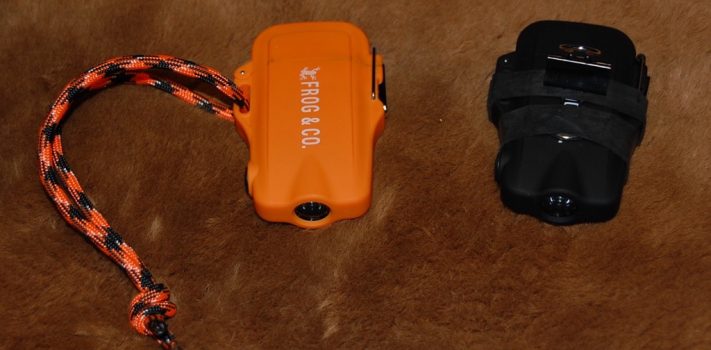Recently, the Senior Pastor of my church gave me a gift. It is a Frog & Co. Tough Tesla Lighter 2.0. It is a great blessing to have a Senior Pastor who faithfully teaches the word of God. It is a bonus that he also recognizes that we live in a dangerous world, and tries to help his flock to be prepared.
This lighter was my first experience with a product from Survivalfrog.com. I visited their website, and noticed that they have many interesting items for sale. My first impression was that some of the items seemed to be priced a little on the high side. Other items seemed to be somewhat impractical, better suited for stocking the shelves of armchair theorists than for use in real-life situations. Still other items looked genuinely useful and reasonably priced. These initial impressions may be unfair. I invite Survivalblog readers with more extensive experience with Survivalfrog to weigh in with their observations.
On the Survivalfrog website, the lighter was listed as an “Outdoor Waterproof Dual Arc Plasma Lighter”. There it was priced at $29.97. The exact same lighter was listed by Survivalfrog elsewhere for about half the price. I noticed that this was true of many of their other products as well. I am not sure what rationale lies behind this pricing strategy.
Opening the Box
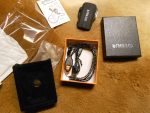 I found the box to be somewhat fancier than necessary. I prefer less hat and more cow, but the hat was very nice. An outer plastic bag protected a sturdy cardboard box with an attractively textured lid. The lid was embossed with silver letters saying “Frog & Co.” Unfortunately, the words “Made in China” were found on the bar code label on the back of the box. An instruction card inside of the box featured a picture of the lighter with the major parts labeled. I noted that the URL listed on the card was “FrogAndCo.com.” That URL auto-redirects the web browser to the Survivalfrog.com website.
I found the box to be somewhat fancier than necessary. I prefer less hat and more cow, but the hat was very nice. An outer plastic bag protected a sturdy cardboard box with an attractively textured lid. The lid was embossed with silver letters saying “Frog & Co.” Unfortunately, the words “Made in China” were found on the bar code label on the back of the box. An instruction card inside of the box featured a picture of the lighter with the major parts labeled. I noted that the URL listed on the card was “FrogAndCo.com.” That URL auto-redirects the web browser to the Survivalfrog.com website.
 Under the instruction card, the lighter was nestled in a second plastic bag, lying in a plastic tray that is covered with faux black velvet. Under the tray, the box contained a neck lanyard made of paratinder with an attached whistle, and a USB charging cord. The directions indicate that the user should utilize only the supplied cord when charging the lighter. This is impractical due to the short length (eight inches) of the cord. I used my phone charger instead throughout the testing of this unit.
Under the instruction card, the lighter was nestled in a second plastic bag, lying in a plastic tray that is covered with faux black velvet. Under the tray, the box contained a neck lanyard made of paratinder with an attached whistle, and a USB charging cord. The directions indicate that the user should utilize only the supplied cord when charging the lighter. This is impractical due to the short length (eight inches) of the cord. I used my phone charger instead throughout the testing of this unit.
The directions indicate that a blue light will show when the unit is charging, and that the light will turn off when charging is complete. Recommended charging time is approximately two hours.
The directions indicate that there is a 10 second time-out feature on the plasma arcs. They also warn that touching the nodes while the arcs are engaged “will give you a small shock.” They explain that to use the paratinder to start a fire, one should cut the lanyard to expose the tinder core, pull out the tinder, and ignite it.
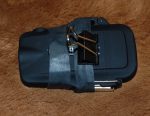 The lighter is made of zinc alloy with a waterproof ABS plastic case. The battery is rated to provide 300 lights between charges. Its capacity is listed as 220 mAh, which was not inspiring. The Morisk plasma lighter that I reviewed for SurvivalBlog on January 10, 2021 has a 330 mAh battery. In spite of its stronger battery, the Morisk lighter was not able to sustain an arc under cold weather conditions. As a result, I was not optimistic that the Survivalfrog lighter would function under similar cold conditions.
The lighter is made of zinc alloy with a waterproof ABS plastic case. The battery is rated to provide 300 lights between charges. Its capacity is listed as 220 mAh, which was not inspiring. The Morisk plasma lighter that I reviewed for SurvivalBlog on January 10, 2021 has a 330 mAh battery. In spite of its stronger battery, the Morisk lighter was not able to sustain an arc under cold weather conditions. As a result, I was not optimistic that the Survivalfrog lighter would function under similar cold conditions.
The lighter includes a flashlight which is rated at 100 lumens on the bright setting. It also has low and strobe settings. The rescue whistle is rated at 120 decibels. The instruction sheet also includes phone and email contact information for customer support.
First Impressions
The lighter is a pleasant size, shape and weight. The ABS case feels faintly rubbery, and is very easy to grip. The lanyard hole is a reasonable size (large enough to accommodate paracord). The pull down sealing latch on the lid is made out of wire about the size of a large paper clip. It does not look overly sturdy.
A button near the base of the unit controls the flashlight, and cycles through the following settings: bright/off/low/off/strobe/off. When the pull-down sealing latch is disengaged, the lid of the lighter pops open at the push of a button. The lid is ABS plastic, but appears more durable than the lid of the Morisk unit that I previously reviewed. The button is closer to the arcs than is the case for the Morisk unit. This makes it more difficult to activate the arcs while holding the lighter in a convenient position in relation to tinder while starting a campfire. The arcs do indeed time out after 10 seconds as advertised.
The charging port is located under the lid. There is a rubber o-ring to provide water resistance around the junction where the lid meets the main body of the lighter. I was surprised and pleased to find that the whistle really is piercingly loud.
I plugged the unit into a charger at 9:00 pm. By 9:55 pm, the unit was fully charged.
The Barn Test
As I mentioned above, I previously tested a plasma lighter made by Morisk. That lighter did not operate reliably under cold weather conditions. So my first order of business was to place the Survivalfrog unit in my unheated barn to see if it functioned any better under similar conditions.
When I had tested the Morisk unit, it failed to operate at 22 degrees Fahrenheit. I was pleased to find that the Frog unit functioned reliably at that temperature. I was also surprised, because as I mentioned above, the Morisk unit has higher battery capacity than the Frog unit.
I wondered if I had made an error in my testing of the Morisk unit, so I recharged that unit and tested it side by side with the Frog unit. My initial test results were confirmed. The Frog unit functioned reliably at 22 degrees, while the Morisk unit did not. Perhaps the electronics in the Frog unit are better designed than those in the Morisk unit.
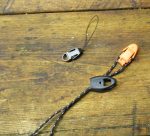 My area experienced unusually mild winter weather early in the testing period. This made effective cold weather testing difficult. After 17 days of testing, we finally had a night with temperatures in the teens, with a low of 15 degrees Fahrenheit. I could still light a fire with the Frog unit, but it could not sustain an arc. The lighter could make just enough of a spark to ignite a cotton ball before it went out. I wondered if this was due to the battery being depleted by 17 days of testing, or if it was due to the lower temperature. I decided that I needed to do further testing under more controlled conditions.
My area experienced unusually mild winter weather early in the testing period. This made effective cold weather testing difficult. After 17 days of testing, we finally had a night with temperatures in the teens, with a low of 15 degrees Fahrenheit. I could still light a fire with the Frog unit, but it could not sustain an arc. The lighter could make just enough of a spark to ignite a cotton ball before it went out. I wondered if this was due to the battery being depleted by 17 days of testing, or if it was due to the lower temperature. I decided that I needed to do further testing under more controlled conditions.
The Freezer Test
I purchased a freezer thermometer from a local big box store. I placed it in the top tray of our chest freezer. The thermometer revealed that the temperature in the freezer was zero degrees Fahrenheit. I then re-charged both the Frog unit and the Morisk unit, refueled my permanent metal match, and placed all three items in a ziplock bag together with the thermometer. I placed this bag with its contents in the top tray of the freezer overnight.
The next morning, neither the Frog unit nor the Morisk unit could sustain an arc. The permanent metal match, on the other hand, ignited immediately.
Of Twine and Lint and Cotton Balls
One advantage of lighting dozens of fires over a period of weeks is that it gave me a good chance to experiment with the effectiveness of various tinders. The tinders I tested included three different kinds of twine, dryer lint, cat tail fluff, birch bark, and cotton balls. I found cotton balls dabbed with petroleum jelly to be the easiest and most consistent tinder to use with this lighter. Birch bark was also highly effective. The other tinders also all worked, but they did not work as well.
Bacon Grease
I also experimented with using bacon grease instead of petroleum jelly as an accelerant with the various tinders. Bacon grease worked, sort of. Since it has a higher flash point than petroleum jelly, it was more difficult to ignite, and it did not burn as vigorously once it was ignited. It would also have the drawback of being more attractive to bears than petroleum jelly. If you do not happen to have any petroleum jelly, bacon grease may be better than nothing. It depends on your evaluation of the relative risks of hypothermia and bear attack.
Paratinder
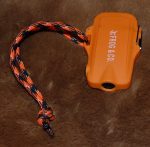 I wanted to test the effectiveness of the paratinder, but did not wish to cut up my neck lanyard. I contacted Survivalfrog to ask them if they had any extra paratinder laying around that I could use in testing. They replied that they did not have any extra paratinder. Instead, they offered to send me a second complete lighter package. They asked if I preferred orange or black. Since the unit that I had received from my Senior Pastor was orange, I requested that the second unit be black.
I wanted to test the effectiveness of the paratinder, but did not wish to cut up my neck lanyard. I contacted Survivalfrog to ask them if they had any extra paratinder laying around that I could use in testing. They replied that they did not have any extra paratinder. Instead, they offered to send me a second complete lighter package. They asked if I preferred orange or black. Since the unit that I had received from my Senior Pastor was orange, I requested that the second unit be black.
After the second unit arrived, I took the lanyard from the box, opened up the whistle and freed one end of the paratinder. I then cut off a piece that was about one inch long and removed the tinder core from the outer sheath. Finally, I lit the tinder. It self-extinguished after it had burned about 1/4 inch.
Next, I unraveled the remaining 3/4 inch of tinder into three strands and relit them. They burned better, but not all the way to the end of the strands.
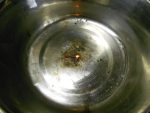 I cut another inch of paratinder, removed the tinder from the sheath, and unraveled it into three strands. This was becoming increasingly difficult to do as my fingers became stiff with cold. I then rolled the three strands into a ball and lit it. It burned well, but was quickly consumed by the flame. I next cut a two inch piece of paratinder, removed the tinder from the sheath, unraveled it into three strands, rolled the strands into a ball, and lit it. The ball burned okay for about as long as a match remains lit. So with proper preparation, paratinder burns okay. In dry conditions, better sources of natural tinder should be available. Under wet conditions, there is barely enough tinder in the entire lanyard to ignite kindling. So if your life is ever at stake, I hope you have a more abundant source of tinder with which to light your fire.
I cut another inch of paratinder, removed the tinder from the sheath, and unraveled it into three strands. This was becoming increasingly difficult to do as my fingers became stiff with cold. I then rolled the three strands into a ball and lit it. It burned well, but was quickly consumed by the flame. I next cut a two inch piece of paratinder, removed the tinder from the sheath, unraveled it into three strands, rolled the strands into a ball, and lit it. The ball burned okay for about as long as a match remains lit. So with proper preparation, paratinder burns okay. In dry conditions, better sources of natural tinder should be available. Under wet conditions, there is barely enough tinder in the entire lanyard to ignite kindling. So if your life is ever at stake, I hope you have a more abundant source of tinder with which to light your fire.
Shelf Life
One factor to consider as one evaluates potential fire-starting methods is shelf life.
I have a couple of ferrocerium rods that are more than 40 years old. They still create sparks just as effectively as they did when they were brand new.
I recently opened a plastic, screw-top canister containing fire-starting materials. It had been stored in various attics, garages, and barns over the course of 25 years, subject to a wide variety of temperature and humidity conditions. The canister contained a couple of butane lighters, a handful of strike-anywhere matches, a box of waterproof matches, and a cheap book of paper matches.
The butane had leaked out of the lighters over the years. The tips of the strike-anywhere matches crumbled away when I attempted to use them. The waterproof matches lighted well. And, much to my surprise, the cheap paper matches lighted well too.
Like the butane lighters, a permanent metal match would probably experience total fuel depletion over the course of decades. The battery charge in a plasma lighter would also likely dissipate. If you consistently use and maintain your primary fire starting method, it is fine if it is something with a shorter shelf life. But for your secondary and especially your tertiary fire starting method, something with an extremely long shelf life is highly desirable. It may be a long time before you ever need your secondary or tertiary fire starting method. But if you need it, you may need it very badly. Absolute long-term reliability is a must.
The Immersion Test
 I wanted to verify whether or not the Frog plasma lighter is truly waterproof. I placed the unit in a mug of water, and set a timer for an hour. When the timer went off, I took the unit out of the mug, wiped the excess water off the case, opened the lid, and pressed the button. It worked perfectly.
I wanted to verify whether or not the Frog plasma lighter is truly waterproof. I placed the unit in a mug of water, and set a timer for an hour. When the timer went off, I took the unit out of the mug, wiped the excess water off the case, opened the lid, and pressed the button. It worked perfectly.
The Dog Walk Test
After completing my testing of the lighter component, I decided to also test the flashlight component. Every day I walk the dog and attend to other outdoor tasks in the dark. Using the unit while completing these tasks would give me a sense of its usefulness.
I like to have my hands free while I am walking the dog and working outside. I rigged the unit as a headlamp by attaching it to a medium binder clip with a couple of rubber bands cut from a bicycle inner tube.
I used the unit primarily on the medium setting. It was quite bright. The beam was more of a spot, and less of a flood. The angle of the beam was surprisingly good when clipped to the brim of my jeep cap. Overall, I was pleased with the performance of the unit on the dog walk test.
The Endurance Test
I also wanted to see how long the flashlight would function on medium beam after being freshly charged. I turned on the light at 2:41 pm. It was still shining brightly at 7:20 pm. But by 8:20 pm, the light was out. So on medium beam with a full charge, the light will shine for at least four hours and forty minutes, but for less than five hours and forty minutes. I personally feel that a good flashlight should be able to function for eight hours on a single charge. This flashlight does not meet that standard.
The Pocket Test
The pocket test is an assessment of durability. The items in my pockets each day take quite a beating. For example, the Maglite Solitaire and Victorinox MiniChamp that I usually carry in my left front pocket look a little like they have been through a cement mixer. Now it was time to see how the Frog unit would hold up to that abuse.
I had chickened out of the pocket test with the Morisk unit. I was afraid that the cap would fall off, the button would depress, and the lighter would start my pants on fire. In addition to the pain that this would cause, it would be acutely embarrassing. People who heard about the incident would have my name come to mind whenever they heard the chant, “Liar, liar, pants on fire. Nose as long as a telephone wire.”
The Frog unit seemed durable enough that I felt confident subjecting it to the pocket test. I replaced the Maglite Solitaire in my pocket with the Frog unit. I also replaced the Victorinox MiniChamp with a Victorinox Swiss Army Classic SD. The SD is smaller than the MiniChamp, so it fit in better with the Frog unit, which is larger than the Solitaire. I felt that I had sufficient tools with the SD, because I was testing a Leatherman Skeletool inside the waistband of my pants at the same time. If the Skeletool had a pair of scissors, I probably would have dispensed with a second knife altogether, although the tweezers on the SD are also handy.
An Aside: The Origin of the Victorinox Name
By the way, I had an “Aha” moment as I was contemplating the switch from the MiniChamp to the SD. I was thinking about the name “Victorinox” and wondering about its origin. I was thinking of it as “Victori-nox” and wondering if it had something to do with “victory at night” from the Latin. Suddenly I realized that the name was “Victor-inox”, with the “inox” being the French word for stainless steel. A search of the Internet revealed that the founder did indeed incorporate “inox” into the name to mean “stainless steel”. He derived the first part of the name from the name of his mother, “Victoria”, the year she died.
In any case, the Frog unit is comfortably shaped to ride well in a pocket, even alongside an ink pen and a small pocket knife. It is durable enough that my pants were never in danger of being ignited by a broken cap. The unit showed absolutely no signs of wear and tear after more than a week of carry. The flashlight portion of the unit gives better light than the Solitaire, so I found myself using it more often. So all in all, I was satisfied with the unit’s performance in the pocket test.
Conclusions
The Survivalfrog Tough Tesla lighter is fun and easy to use for starting fires. Unfortunately, like butane lighters, or like IMCO lighters fueled by kerosene or gasoline, this plasma lighter does not operate effectively under cold weather conditions.
If you live in an area where the temperature never drops below 20 degrees Fahrenheit, it might be a good option for you. If you live in a colder area, you will need to make contingency plans to keep the lighter functioning under cold weather conditions. For example, you could use the included neck lanyard to carry the lighter next to your base layer. In this way, your body heat would keep it warm until you were ready to use it.
If you chose this solution, it would be vitally important to have effective cold-weather alternatives readily available for emergencies. For example, imagine that you set the lighter down after starting your evening campfire, and accidently left it out overnight. After being exposed to the cold all night long, it might not arc in the morning. Your secondary and tertiary fire starting methods should be suitable for cold weather use, and easily accessible.
Disclaimer
After the bulk of my testing was already completed, Survivalfrog was kind enough to provide me with a second lighter so that I could test the included paratinder neck lanyard. Most of this review was drafted before Survivalfrog provided this item. I tried not to allow their kindness to influence anything that I wrote after receiving the second unit. I believe that I was able to remain objective. Other than the sample lighter, I did not receive anything that could be considered an inducement to mention any vendor, product, or service in this article.

